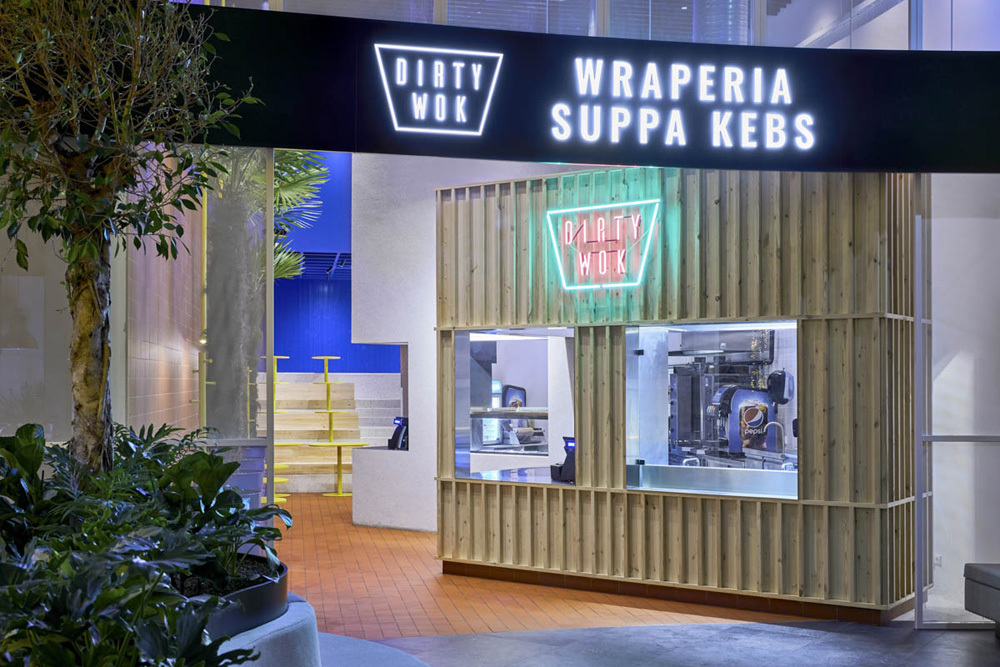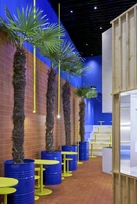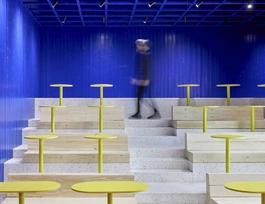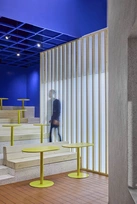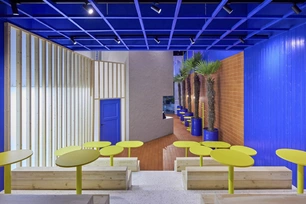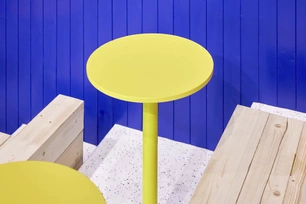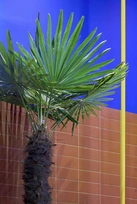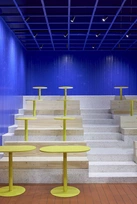Apie projektą:
Bendraautoriai: Tomas Vaičiulis, Rūta Kazėnaitė
Šalis: Lietuva
Plotas: Visas plotas 109; iš jų: restorano salė – 60; Virtuvė – 26; Uždara virtuvė – 17; kitos patalpos – 6;
Wraperia Suppa Kebs/ Dirty Wok
Naujame Vilniaus prekybos centre suprojektuoti du greito maisto restoranai vienoje erdvėje – Wraperia ir Dirty Wok.
Interjeras siekia pabrėžti šių dviejų maisto vietų idėją – netikėti deriniai bei „skanūs“ kontrastai. Nedidelėje restorano erdvėje buvo suprojektuoti du tūriai, taip sukuriant autentiškus „namus“ kiekvienam iš šių restoranų. Už tūrių suprojektuotas amfiteatras kur abiejų restoranų lankytojai gali mėgautis patiekalais ir dalintis įspūdžiais.
Apdailai naudotos itin skirtingos medžiagos bei spalvos - nuo natūralaus klinkerio plytelių ir gyvo medžio iki beveik neoninių geltonos ir mėlynos spalvų. Balti elementai taip pat sukurti iš neįprastų medžiagų – vieno iš tūrių sienos dengtos baltu mozaikiniu tinku, o amfiteatro grindys dengtos PVC danga, kuri padeda sukurti vientiso laiptų tūrio vaizdą.
Palmės bei neoniniai užrašai lankytoją nukelia į šiltus kraštus ar azijos didmiestį, iš kur ir atkeliavo šie „gatvės“ maisto skoniai.
English
Two fast food restaurants - Wraperia and Dirty Wok - have been designed in one space in a new Vilnius shoppinf center.
The interior seeks to emphasize the idea of these two restaurants - unexpected combinations and "delicious" contrasts. Two volumes have been designed in the small space, thus creating an authentic “home” for each of these restaurants. An amphitheater is designed behind the volumes where visitors of both restaurants can enjoy their dishes and share their impressions.
Very different materials and colors are used as finishes, from natural clinker tiles and pure wood to almost neon yellow and blue. The white elements are also made of unusual materials - the walls of one of the volumes are covered with white mosaic stucco, and the floor of the amphitheater is covered with PVC coating, which helps to create an image of a solid volume of the stairs.
Palm trees and neon signs take the visitor's mind to warm countries or an Asian city, where these "street" food flavors came from.
Nuotraukos: Norbert Tukaj
© 2025 visos teisės saugomos
Norėdami išsaugoti, prisijunkite.
Siekdami užtikrinti geriausią Jūsų naršymo patirtį, šiame portale naudojame slapukus.
Daugiau informacijos ir pasirinkimo galimybių rasite paspaudus mygtuką „Nustatymai“.
Jei ateityje norėsite pakeisti šį leidimą, tą galėsite bet kada galėsite padaryti paspaudžiant portalo apačioje esančią „Slapukų nustatymai“ nuorodą.
Tai portalo veikimui būtini slapukai, kurie yra įjungti visada. Šių slapukų naudojimą galima išjungti tik pakeitus naršyklės nuostatas.
| Pavadinimas | Aprašymas | Galiojimo laikas |
|---|---|---|
| storage_consent | Šiame slapuke išsaugoma informacija, kurias šiuose nustatymuose matomų slapukų grupes leidžiate naudoti. | 365 dienos |
| PHPSESSID | Sesijos identifikacinis numeris, reikalingas bazinių portalo funkcijų (pavyzdžiui, galimybei prisijungti, užildyti užklausos formą ir kitų) veikimo užtrikinimui. | Iki naršyklės uždarymo |
| REMEMBERME | Prisijungimui prie asmeninės paskyros portale naudojamas slapukas. | 1 mėnuo |
| OAID | Portalo vidinės reklaminių skydelių valdymo sistemos slapukas. | 1 metai |
| __eoi | Saugumo paskirtį atliekantis Google paslaugose (Google AdSense, AdSense for Search, Display & Video 360, Google Ad Manager, Google Ads) naudojamas slapukas. | 6 mėnesiai |
| sender_popup_shown_* | Naujienlaiškio užsakymo formos nustatymai. | 1 mėnuo |
Slapukai skirti informacijos apie portalo lankomumą rinkimui.
| Pavadinimas | Aprašymas | Galiojimo laikas |
|---|---|---|
| _ga | Google Analytics statistikos slapukas | 2 metai |
| _ga_* | Google Analytics statistikos slapukas | 2 metai |
Rinkodaros arba reklamos slapukai, kurie naudojami siekiant parodyti pasiūlymus ar kitą informaciją, kuri galėtų Jus sudominti.
| Pavadinimas | Aprašymas | Galiojimo laikas |
|---|---|---|
| test_cookie | Naudojamas Google paslaugose (Google AdSense, AdSense for Search, Display & Video 360, Google Ad Manager, Google Ads). | 15 minučių |
| __Secure-3PAPISID | Naudojama Google paslaugose vartotojo nustatymų ir informacijos saugojimui. | 13 mėnesių |
| __Secure-3PSID | Naudojama Google paslaugose vartotojo nustatymų ir informacijos saugojimui. | 13 mėnesių |
| _fbp | Facebook platformos slapukas. | 90 dienų |
| _fbc | Facebook platformos slapukas. | 90 dienų |
| datr | Facebook platformos slapukas. | 1 metai |

